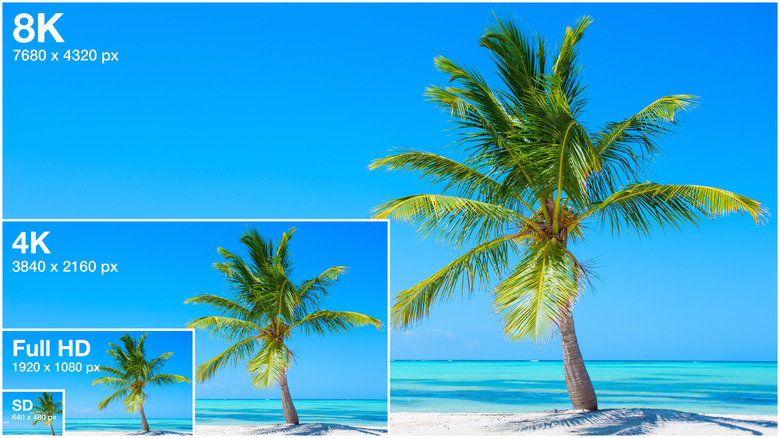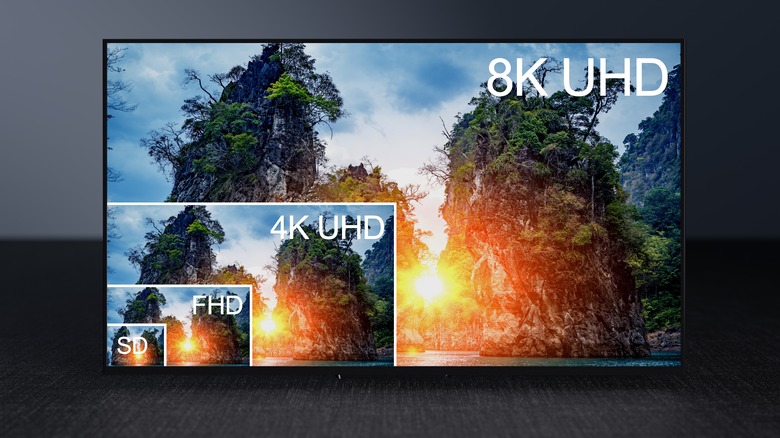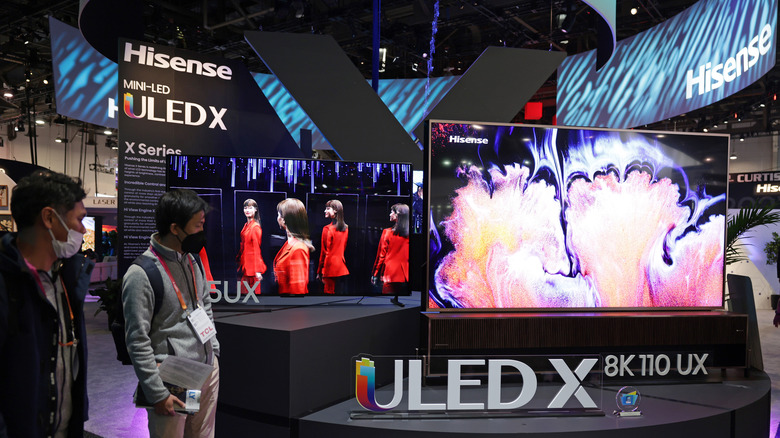Is An 8K TV Worth It? What You Need To Know
We may receive a commission on purchases made from links.
If you've been in the market for a new TV in the last few years or even just browsing at an electronics store, then you may have noticed how the landscape has changed as far as what's available for you to buy. 4K TVs are now near-ubiquitous, with 720p and 1080p HDTVs only available in smaller sizes, generally 43 inches or less. But while 4K TVs are now available at virtually all possible price points, they're joined by 8K TVs, which have four times the resolution by doubling the number of pixels on each axis.
In stores, with the demo material that's playing on them, these 8K TVs look ridiculously gorgeous, but they're also ridiculously expensive. Of course, those demos are designed to make the TVs look as amazing as possible. And if you really think about it, that's not the only way the in-store experience is a far cry from what you'd experience at home. In a store, you're generally going to get very close to a TV — at least close enough to read the price tag — which is significantly closer than you'd ever watch a TV of that size in your own home. And that demo material? You may have noticed that it's generally the only thing playing on 8K TVs, and it's usually artwork or nature videos that might occasionally be supplemented by movie trailers but never any actual movies.
There are some major caveats involved with 8K TVs as they sit right now, so let's go over a few of them to make sure you don't overspend when looking for a new television.
The content isn't there yet
Arguably, the biggest problem that makes 8K TVs not worth the premium right now, is that the content just isn't there yet. Realistically, it's not even close to being there. There are plenty of gorgeous 8K demo videos showcasing nature, wildlife, tropical locales, and the like on YouTube and Vimeo, but that's about all there is that the average person can stream. And although 4K is becoming more ubiquitous by the day, 4K broadcast television coverage is still patchy in the U.S. 8K broadcasts aren't even close.
Here's another sign of how far off the 8K content is: In July 2023, Samsung got some consumers' hopes up by announcing in a press release that it was partnering with Warner Bros. Pictures to supply 8K content in the form of movie trailers. These could only be viewed as tech demos in retail stores and wouldn't be available for consumers to stream at home. Some announcement, huh?
Gaming is also not ready for 8K, either. Although some latest-generation consoles such as the Sony PS5 and Microsoft Xbox Series X have 8K capable hardware, few games are available, and while nVidia's 8K card — the RTX 3090 — is capable of playing games such as World of Tanks in native 8K resolution, more demanding games are typically rendered at 1440p and upscaled to 8K.
All told, we're still a ways away from any kind of substantial 8K content available to the public.
The benefits of 8K mean little to the end user
A higher resolution is nice, but the human eye can only process so much. According to experts, though the jump from 1080p HD to 4K is noticeable under the right conditions, the increase from 4K to 8K is where diminishing returns really start to take hold.
"It turns out that for a screen 60" wide viewed from five feet away, the limit of our resolution is 4K," explained MIT Vision and Computational Neuroscience professor, Pawan Sinha, in a January 2022 Gizmodo article. "At this distance, we would be able to tell the difference between HD and 4K, but any increase beyond 4K (say, to 8K) would not be noticeable. We would need to get right up close to the TV (quite an unnatural thing to do) to tell apart a 4K screen from an 8K one."
In the same article, Martin S. Banks, a UC Berkeley professor of Optometry, Vision Science, Neuroscience, and Psychology, explained that, "you'd have to be two feet from your three-foot television to appreciate the resolution." Other experts agreed with the gist: Even with excellent vision, 8K TVs don't make sense for most people in most viewing conditions.
The main benefits of 8K come on the production side. Shooting in 8K allows you to zoom in on a quadrant of the picture and still have a perfectly usable native 4K image. Even beyond entertainment, that allows for some interesting applications, like zooming in on security camera footage.
8K TVs can cost double or triple comparable 4K TVs
Even with the paucity of content and the inability of most people to see the benefit of the upgrade, 8K TVs are still a fairly new, premium product. That comes at a premium cost, sometimes as much as double the price of a comparable 4K TV.
The best way to compare prices of 4K TVs vs. 8K TVs is to use TVs from a comparable model series. Samsung has both 4K and 8K TVs available as part of its Neo QLED series, so that seems like as good a place as any to start. At 65 inches, the starting size for Samsung's 8K TVs, there are two 4K TVs in the Neo QLED series: The 65-inch version of the QN85C that retails for $1,999.99 and its counterpart among the QN90C models, which has an MSRP of $2,799.99. At 8K, that retail price goes up to $3,499.99 for the 65-inch iteration of the QN800C and a whopping $4,999.99 for its 65-inch QN900C cousin. As this is being written, Samsung does have a sale on these models, but even at discounted prices, the 8K TVs are still around double the price of their 4K cousins.
The difference is even more stark if we take a look at LG's TVs. Samsung's fellow South Korean electronics behemoth has TVs at both resolutions in its PUA Series, with 77 inches being the overlapping size. In that case, the 8K version retails for more than three times the price of the 4K version: $9,999.99 for the 8K panel as opposed to $3,299.99 for the 4K one.
Even if you find content, it's incredibly demanding of your internet connection
As noted earlier, an 8K image, with the number of pixels being doubled on each axis, has room within it for four separate 4K images. And though video compression technology continues to improve, that still means that a lot of data throughput is needed to stream 8K video. How much is a lot? So much so that, at the time of writing, Google's help page for recommended internet speeds for YouTube, the leading provider of 8K content, doesn't have an 8K recommendation yet.
For 4K videos, Google suggests a sustained speed of 20 megabits per second, so with the same AV1 compression used for 4K also being used for 8K videos, it's safe to say you'll need a lot more throughput for the 8K content. HighSpeedInternet.com, for example, recommends a sustained speed of 100 megabits per second for 8K videos. If you live in a major metropolitan area, that's possible with the base plans from the likes of Verizon Fios and most major cable companies, but it gets a lot trickier if your household is streaming multiple things at the same time or if you live somewhere with inferior broadband deployment.
So if you're comfortably streaming 4K videos without any noticeable hiccups and internet speed tests show you as having plenty of headroom above 100 megabits per second, then 8K should be doable for you.




